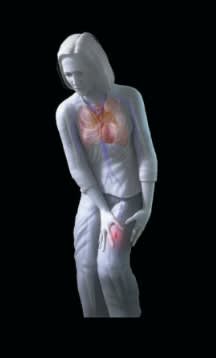
Candy Lugo remembers looking down at her hands and seeing that her fingernails had turned stark white — there was no color in the nail beds at all. Moments earlier, the 40-year-old payroll manager had been getting ready to leave her home in Redondo Beach to join her family for a Memorial Day barbecue, but she suddenly found herself having trouble breathing. She sat down on the bed, glanced at her hands and knew she needed an ambulance.
She remembers, “I knew it wasn’t normal. I kept repeating to the paramedics, ‘I can’t breathe.’ ” As the ambulance made its way to the Providence Little Company of Mary emergency department, Candy says she recalls passing a cemetery. “That was the last thing I saw. Then I was asleep and I kept telling myself I needed to wake up. I was really scared.”
On arrival at the ER, Candy was met by Leonardo Rodriguez, M.D., the attending emergency medicine physician. Struggling hard to breathe, Candy went into cardiac arrest and Dr. Rodriguez called a code blue, summoning Little Company of Mary’s rapid response team to resuscitate her. With heroic action, emergency medicine doctor Michael Perez, M.D., brought Candy back to life.
Suspecting a pulmonary embolism (PE) — a clot cutting off blood circulation in the lungs — Dr. Rodriguez then called a code PE, which triggered another set of emergency procedures designed by interventional cardiologist Rishi Kaushal, M.D., who was on duty that evening. Dr. Kaushal and Dr. Rodriguez had been instrumental in the creation and implementation of the lifesaving code PE protocol a few years earlier..
IMMEDIATE ACTION
The first step in responding to a patient in a code PE is to get a CT scan. Candy’s imaging showed that although she had none of the typical risk factors, there was indeed a large blood clot blocking circulation of blood in both lungs. Although not every blood clot is life-threatening, this one was, and it needed urgent treatment. “This clot was absolutely not survivable,” says Dr. Kaushal.
In the past, the only option for treating severe blood clots was blood thinners, which would not have been effective in time to save Candy. More recently, clot-busting drugs known as thrombolytics have come into widespread use, but they carry their own risks and require a stay in the ICU.
Fortunately for Candy, Dr. Kaushal had a third option: a device made by Inari Medical known as the FlowTriever that was first put into service at Little Company of Mary in 2021. At the time, the hospital was the only one in the South Bay to have the clot-retrieving catheter available, and in this case it saved Candy’s life. “She came in in dire straits,” recalls Dr. Kaushal. “She was in shock.”
In a minimally invasive procedure, Dr. Kaushal threaded a guide wire into Candy’s blood vessels after making an opening in a large artery in her groin. He then followed the wire’s pathway with the catheter, reaching the clot and suctioning it into the catheter to remove the blockage.
NOT OVER YET
Candy awoke the next day to find a ventilator breathing for her. Once the ventilator was removed and she was breathing on her own, she realized that one side of her face was numb. New imaging showed that she had a second clot. Further complicating the situation was a common congenital heart condition: Candy had a hole in her heart between the left and right atria. The hole had allowed some of the clot to slip through and lodge in her brain, causing an ischemic stroke, which was behind the facial numbness Candy experienced.
In a second procedure, Dr. Kaushal used the FlowTriever again to capture and remove the clot and, using a different kind of catheter, placed a tiny plug — a septal occluder — to close the hole in Candy’s heart permanently.
Two years later, Candy is now back at work full-time and has returned to her kickboxing workouts. She still takes anticoagulant medication to reduce the risk of another clot. Of her first-ever hospital stay, she says, “They were super nice; it felt like home.”
WHAT YOU NEED TO KNOW ABOUT VTE
Venous thromboembolisms (VTE), blood clots that form in veins and then block blood flow, are surprisingly common. About 900,000 people develop VTEs each year, and of those, 60,000 to 100,000 die as a result, the Centers for Disease Control reports.
The primary symptom of a VTE that has traveled to the lungs to become a life-threatening pulmonary embolism is difficulty breathing. That’s similar to the symptoms of other cardiac and respiratory crises like a heart attack or severe pneumonia, so if you experience unexplained shortness of breath, call 911.
A particular type of VTE known as deep vein thrombosis (DVT) occurs mostly in the legs. DVT symptoms include swelling, redness and warm skin in the affected area. Because the clot can dislodge and cause a pulmonary embolism, this form of VTE needs urgent medical care as well.

- Age—risk begins rising at age 40
- Smoking
- Obesity
- Being pregnant
- Surgery, especially when immobilized during recovery
- Major injuries, including broken bones
- High blood pressure
- Cancer
- Sitting or not moving for long periods of time






















